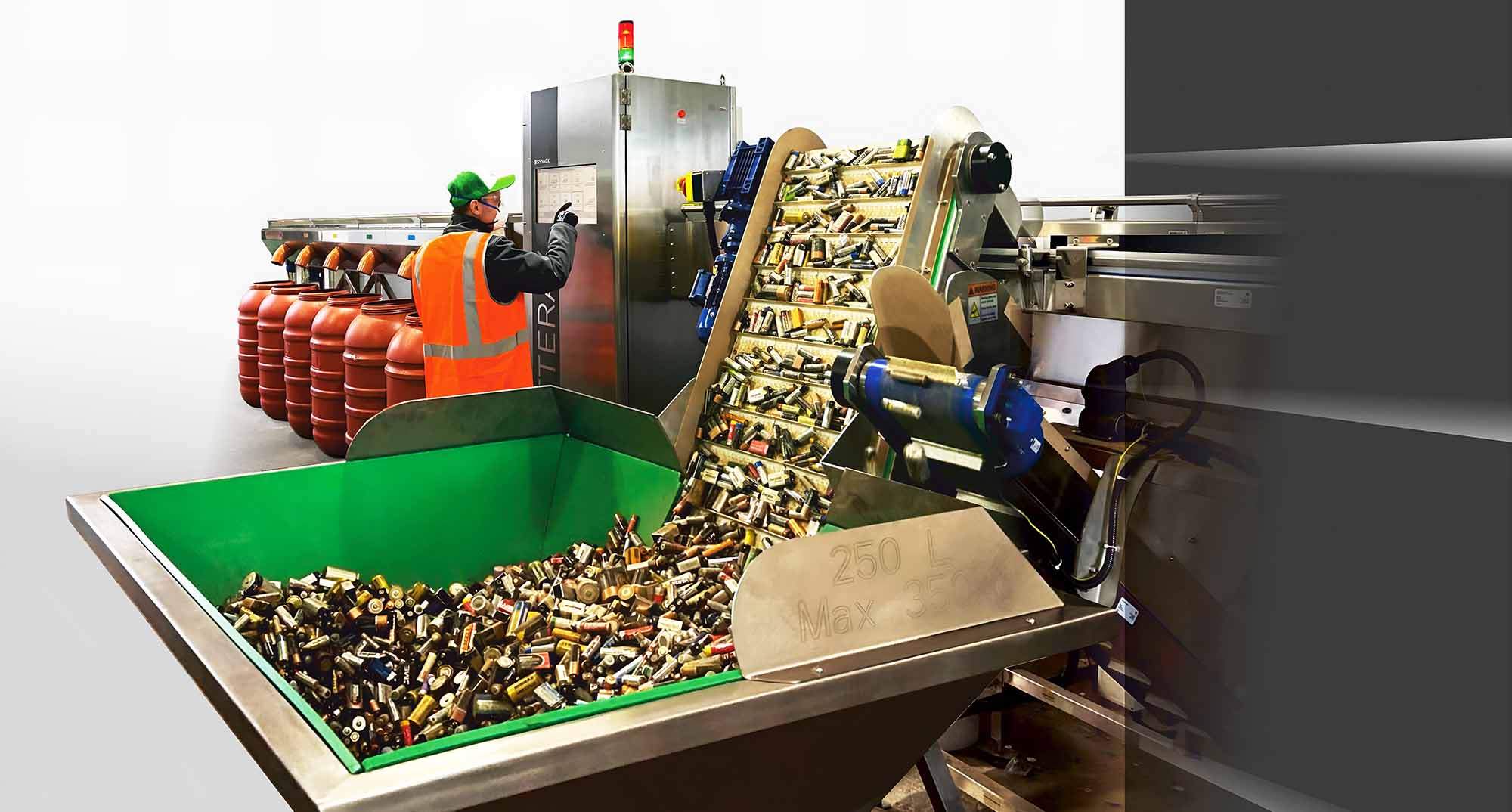“…the cost of fires to the waste and recycling operators
and to the fire professionals who are forced to fight
these fires are more than US$1.2 billion annually“.
“… at least one fire per month at its materials
recovery facility (MRF) due to lithium-ion batteries“.
There are a large number of different types of batteries and accumulators currently on the market. All the batteries in circulation fall into the category of hazardous solid household waste, because depending on the constitution make-up of their electrochemical construction, they contain highly toxic heavy metals such as mercury, cadmium or lead in various concentrations. According to scientific reports, used batteries make up to 40% of all toxic substances that enter the environment along with household waste. It should be noted that batteries and accumulators contain expensive metals such as silver, nickel, cadmium or zinc in concentrations that are much higher than the concentration of these metals in natural ores.
However, demand for Batteries and accumulators, dominated by the EV market segment is a constantly growing market. In order to prevent toxic heavy metals from entering the environment with household waste, to eliminate the risk of explosion or fire solutions at recycling or disposal, to increase efficiency in sorting and removal of such elements, and to support industry by more economic access to recycled high-grade raw materials LINEV Systems developed an innovative solution. This in part has become necessary as the use or recycled raw materials from used batteries or accumulators is in high demand by the industry. The issue of collection, sorting and recycling of batteries and accumulators has therefore become a global challenge and opportunity. To solve this problem, LINEV Systems provides a complete solution BATTERAY for identifying and sorting used batteries.
We met with Neil Harrington, Head of Business Development & Distribution, LINEV Systems UK, for a nice chat about the new LINEV Systems solution and the global issue of detecting and sorting used batteries.
Today we are ready to present a new solution — X-ray Structural Batteries Detection System (in sorted waste) BATTERAY WD. Why did LINEV Systems decide to develop a new solution?
The need to develop the Batteray WD solution was identified in several recent UK calls with prospective customers regarding our automatic sorting system for nonlabelled batteries BATTERAY, a solution that sorts batteries based on highly efficient X-ray analysis. The benefits of this solution have been thoroughly identified. However, in discussions with Re-cyclers the need for a more general solution to identify batteries in general waste was identified and hence the development of X-ray Structural Batteries Detection System BATTERAY WD was conceived. This system is specifically designed for automatic detection of batteries in waste. We will present this new solution at the International Security Expo (Sep. 27-28) and in the future at several other relevant exhibitions.
X-ray Structural Batteries Detection System BATTERAY WD
— Correct battery disposal is a big problem all over the world. How is this problem being resolved today?
— Yes, in our opinion the identified need for battery detection in waste presents a potential global issue to address, many mature markets such as UK and many EU countries have legislation in place such as WEEE in the UK the amount of waste electrical and electronic equipment (widely known as WEEE or e-waste) generated every year in the UK and EU is increasing rapidly. It is now one of the fastest growing waste streams, UK and EU rules on WEEE aim to contribute to sustainable production and consumption. They address environmental and other issues caused by the growing number of discarded electronics including batteries in the EU.
We are witnessing a growing market for mobile collection and disposal service companies appearing throughout UK and Europe that act as the supply chain for the more established recycling organisations. It should be noted that many batteries are hazardous waste; some are dangerous goods and in order to comply with UK and EU legislation, they must be handled carefully and safely disposed of – ideally recycled. Hazards include contamination risk and in extreme circumstances fire risk.
Waste from electrical and electronic equipment includes a large range of devices such as computers, refrigerators and mobile phones at the end of their life. This type of waste contains a complex mixture of materials, some of which are hazardous. These can cause major environmental and health problems if the discarded devices are not managed properly. In addition, modern electronics contain rare and expensive resources, which can be recycled and re-used if the waste is effectively managed. Improving the collection, treatment and recycling of electrical and electronic equipment (EEE) at the end of their life can improve sustainable production and consumption, increase resource efficiency and contribute to the circular economy.
WEEE Directive
— The UK & EU has introduced the WEEE Directive to tackle the issue of the growing amount of WEEE entering landfill. What are the key concepts included in the Directive?
— The WEEE Directive and therefore the application of Batteray and Batteray WD aims to contribute to the elimination of discarded batteries entering the waste material landfill which would then convert to sustainable production and consumption by:
- preventing the creation of WEEE as a first priority
- contributing to the efficient use of resources and the retrieval of secondary raw materials through re-use, recycling, and other forms of recovery
- improving the environmental performance of everyone involved in the life cycle of EEE
- In order to achieve these objectives, the Directive:
- requires the separate collection and proper treatment of WEEE and sets targets for their collection as well as for their recovery and recycling
- helps UK & European countries fight illegal waste exports more effectively by making it harder for exporters to disguise illegal shipments of WEEE
- reduces the administrative burden by calling for the harmonisation of national and international EEE registers and of the reporting format
— LINEV Systems is an innovative expert in the field of non-destructive testing. Will the company expand its «green-focused» activity?
— LINEV Systems is actively developing its «green» activity related to the search for solutions to improve the environmental contamination problems in the world.
We are committed to supporting industry and assist in the circular economy and recycling market because, moving towards a circular economy is critical from both supply security and environmental perspectives.
By LINEV Systems developed AI, Analyses Software and Service we can provides a sustainable and innovative contribution to the basis for a sustainable and competitive economy.




